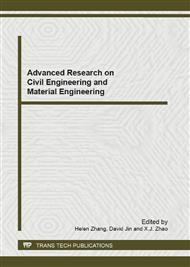p.226
p.230
p.234
p.238
p.242
p.251
p.256
p.260
p.265
Research on Influence of the Bank Slope on the Acceleration Distribution of the Central Points of Concrete-Faced Rockfill Dam
Abstract:
3-D dynamical response analysis of concrete-faced rockfill dam is presented. Using equivalent-linear model, based on different dam heights and different shapes of river valley, the responses of dam subjected to different seismic intensity inputs have been studied. Especially the systematic analysis about the influence of the bank slope on the distribution of the acceleration at the central points the bank slope is conducted. The results show that, the distribution of the horizontal acceleration along the dam heights at the central points on the central section of concrete-faced rockfill dam performs that the acceleration magnification which increases remarkably over 0.8H is a little smaller during 0~0.8H. For high concrete-faced rockfill dam, with the base acceleration excitations unchanged and the bank slope becoming gentle, the maximum acceleration on the top of the dam reduces. Under various seismic intensities, for non-high dams in the broad river valley the slope has almost no impact on the magnification of the horizontal acceleration.
Info:
Periodical:
Pages:
242-247
Citation:
Online since:
September 2012
Authors:
Price:
Сopyright:
© 2012 Trans Tech Publications Ltd. All Rights Reserved
Share:
Citation:


